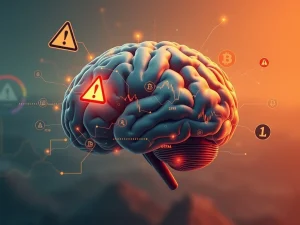AI Reasoning Falls Short: Apple Researchers Reveal Surprising AGI Gap

The buzz around Artificial General Intelligence (AGI) reaching human-level capabilities has been intense, fueled by rapid advancements in large language models. Many in the tech and crypto spaces watch closely, anticipating the transformative impact of true AGI. However, recent research from Apple offers a dose of reality, suggesting that current **AI models** are still a significant distance from achieving genuine **AI reasoning** comparable to human intelligence.
What Did the Apple AI Research Uncover?
Apple researchers published a paper titled “The Illusion of Thinking,” which delves into the fundamental capabilities and limitations of leading large reasoning models (LRMs) found in popular AI chatbots like OpenAI’s and Anthropic’s. They argue that standard evaluations, which often focus solely on final answer accuracy in math or coding tasks, don’t truly measure **AI reasoning** ability.
To get a clearer picture, the researchers designed novel puzzle games that required more than just recall or pattern matching. They tested both ‘thinking’ (LRM-enhanced) and ‘non-thinking’ variants of several prominent models, including Claude Sonnet, OpenAI’s o3-mini and o1, and DeepSeek-R1 and V3.
Are Current AI Models Capable of True Reasoning?
The findings from the **Apple AI research** challenge the notion that current models are on the cusp of **Artificial General Intelligence**. Here are the key takeaways:
- **Accuracy Collapse:** Frontier LRMs experienced a complete failure in accuracy when faced with puzzles beyond a certain complexity level.
- **Lack of Generalization:** The models struggled to apply reasoning effectively across different puzzle types or increasing complexity. Their performance edge diminished significantly as tasks became harder.
- **Inconsistent Logic:** Researchers observed that models failed to use explicit algorithms reliably and reasoned inconsistently even within the same puzzle type.
- **The Problem of Overthinking:** Surprisingly, some AI chatbots would initially arrive at a correct intermediate step or answer but then ‘overthink’ or wander into incorrect reasoning paths.
These results indicate that while current **AI models** can mimic reasoning patterns based on the vast data they were trained on, they do not appear to truly internalize or generalize these patterns in a flexible, human-like way. This is a crucial distinction when aiming for **AGI**.
Contrasting with AGI Timelines: Is AGI Still Years Away?
The **Apple AI research** provides a stark contrast to some optimistic predictions about the timeline for achieving **Artificial General Intelligence**. For instance:
- OpenAI CEO Sam Altman expressed confidence in January, stating the firm felt closer than ever to building AGI as traditionally understood.
- Anthropic CEO Dario Amodei suggested in November that AGI could exceed human capabilities within the next year or two, potentially by 2026 or 2027, based on current progress rates.
While progress is undeniable, the Apple findings suggest there might be fundamental barriers or limitations in current approaches that prevent the leap from sophisticated pattern matching to genuine, generalizable **AI reasoning**. The “illusion of thinking” described by the researchers implies that what looks like reasoning might simply be a highly advanced form of prediction and pattern completion, which breaks down when faced with novel or sufficiently complex logical challenges.
What Does This Mean for the Future of AI?
The study doesn’t negate the impressive capabilities of modern **AI models** for specific tasks like writing, translation, or coding assistance. However, it highlights the significant work still needed to achieve true **AGI**. It suggests that future research may need to explore entirely new architectural approaches or training methodologies to overcome these fundamental limitations in generalizable **AI reasoning**.
For industries watching AI development closely, including Web3 and decentralized finance, this research underscores that while AI tools will continue to improve and find new applications, the dream of a single, human-level **Artificial General Intelligence** might still be a distant goal, requiring breakthroughs beyond simply scaling up current models.
Summary: The Current State of AI Reasoning
In conclusion, Apple researchers’ work provides valuable insights into the current state of advanced **AI models**. By testing these models with novel puzzles designed to probe genuine logic and generalization, they found significant limitations. Current LRMs exhibit an accuracy collapse at higher complexity, fail to reason consistently, and sometimes ‘overthink.’ This suggests that while they are incredibly powerful tools that can mimic human-like responses, they lack the deep, flexible **AI reasoning** required for **AGI**. The path to true **Artificial General Intelligence** remains challenging, requiring more than just incremental improvements to existing architectures.









